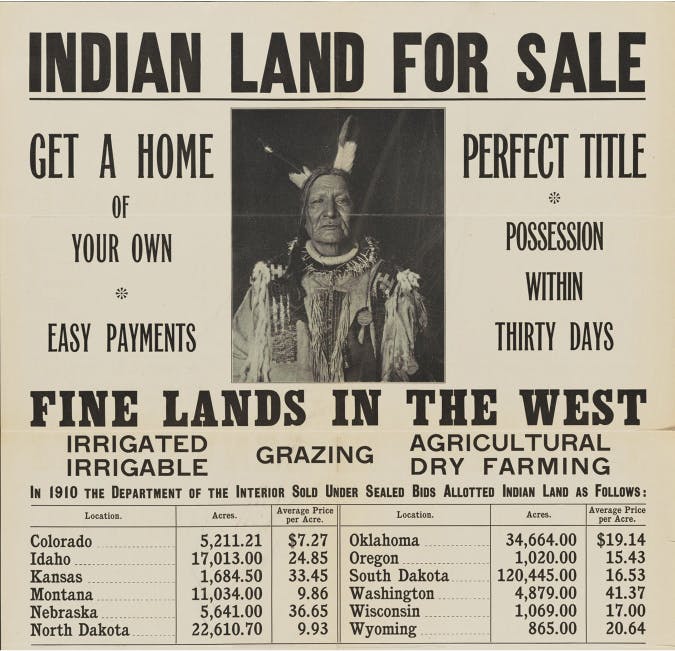The Dawes Act, 1887
Use this primary source text to explore key historical events.
Suggested Sequencing
- Use this Primary Source after reading the George Custer, Sitting Bull, and the Battle of the Little Bighorn Narrative for context on how the expansion of the United States westward affected American Indians. It should also be used with the Images from the Carlisle Indian School, 1880s Primary Source to allow students to analyze the effect the push for assimilation had on American Indians.
Introduction
The Dawes Act of 1887 was passed in an effort to alleviate American Indian poverty. Most Americans in positions of power believed at the time that it was necessary for American Indians to adopt the Western way of life to emerge from the poverty that existed on the reservations. United States political leaders believed the Indians’ way of life was less civilized and that for them to improve their condition, it was essential for them to adopt the principles of private property. The Dawes Act offered the incentive of full U.S. citizenship to motivate American Indians to accept this change. However, the act was controversial because it also was designed to destroy the social fabric of tribal life and the traditional way of life for many American Indian tribes.
Sourcing Questions
- What economic goals did the Dawes Act seek to accomplish?
- What social goals did the Dawes Act seek to accomplish?
| Vocabulary | Text |
|---|---|
| severalty(n): the condition of being separate; individual ownership | Be it enacted by the Senate and House of Representatives of the United States of America in Congress assembled . . . the President of the United States be, and he hereby is, authorized, whenever in his opinion any reservation or any part thereof of such Indians is advantageous for agricultural and grazing purposes . . . to allot the lands in said reservation in severalty to any Indian located thereon in quantities as follows: |
| To each head of a family, one-quarter of a section; | |
| To each single person over eighteen years of age, one-eighth of a section; | |
| To each orphan child under eighteen years of age, one-eighth of a section; and | |
| To each other single person under eighteen years now living, or who may be born prior to the date of the order of the President directing an allotment of the lands embraced in any reservation, one-sixteenth of a section: . . . | |
| All allotments set apart under the provisions of this act shall be selected by the Indians, heads of families selecting for their minor children, and the agents shall select for each orphan child, and in such manner as to embrace the improvements of the Indians making the selection. . . . That if any one entitled to an allotment shall fail to make a selection within four years after the President shall direct that allotments may be made on a particular reservation, the Secretary of the Interior may direct the agent of such tribe or band, if such there be, and if there be no agent, then a special agent appointed for that purpose, to make a selection for such Indian. . . | |
| That upon the approval of the allotments provided for in this act by the Secretary of the Interior, he shall cause patents to issue therefor in the name of the allotted, which patents shall be of the legal effect, and declare that the United States does and will hold the land thus allotted, for the period of twenty-five years, in trust for the sole use and benefit of the Indian to whom such allotment shall have been made . . . | |
| That upon the completion of said allotments and the patenting of the lands to said allotted, each and every member of the respective bands or tribes of Indians to whom allotments have been made shall have the benefit of and be subject to the laws, both civil and criminal, of the State or Territory in which they may reside; and no Territory shall pass or enforce any law denying any such Indian within its jurisdiction the equal protection of the law. | |
| And every Indian born within the territorial limits of the United States to whom allotments shall have been made under the provisions of this act, or under any law or treaty, and every Indian born within the territorial limits of the United States who has voluntarily taken up, within said limits, his residence separate and apart from any tribe of Indians therein, and has adopted the habits of civilized life, is hereby declared to be a citizen of the United States |
Comprehension Questions
- How much land did the Dawes Act allot to individual Indians?
- How long did individuals have to select their land?
- What happened if an individual did not select their land?
- What conditions came with the allotment of land?
- How were the Indians who accepted the land to be treated by state or territorial law?
- What incentive was offered to Indians who accepted the land, lived apart from their tribe, and adopted a “civilized” (Western) way of life?
Historical Reasoning Questions
- How did the Dawes Act fit into the founding tradition of the United States, with a focus on promoting and protecting natural rights?
- In what ways did the Dawes Act violate the natural rights of American Indians?
Full Text: https://www.ourdocuments.gov/doc.php?flash=false&doc=50&page=transcript
